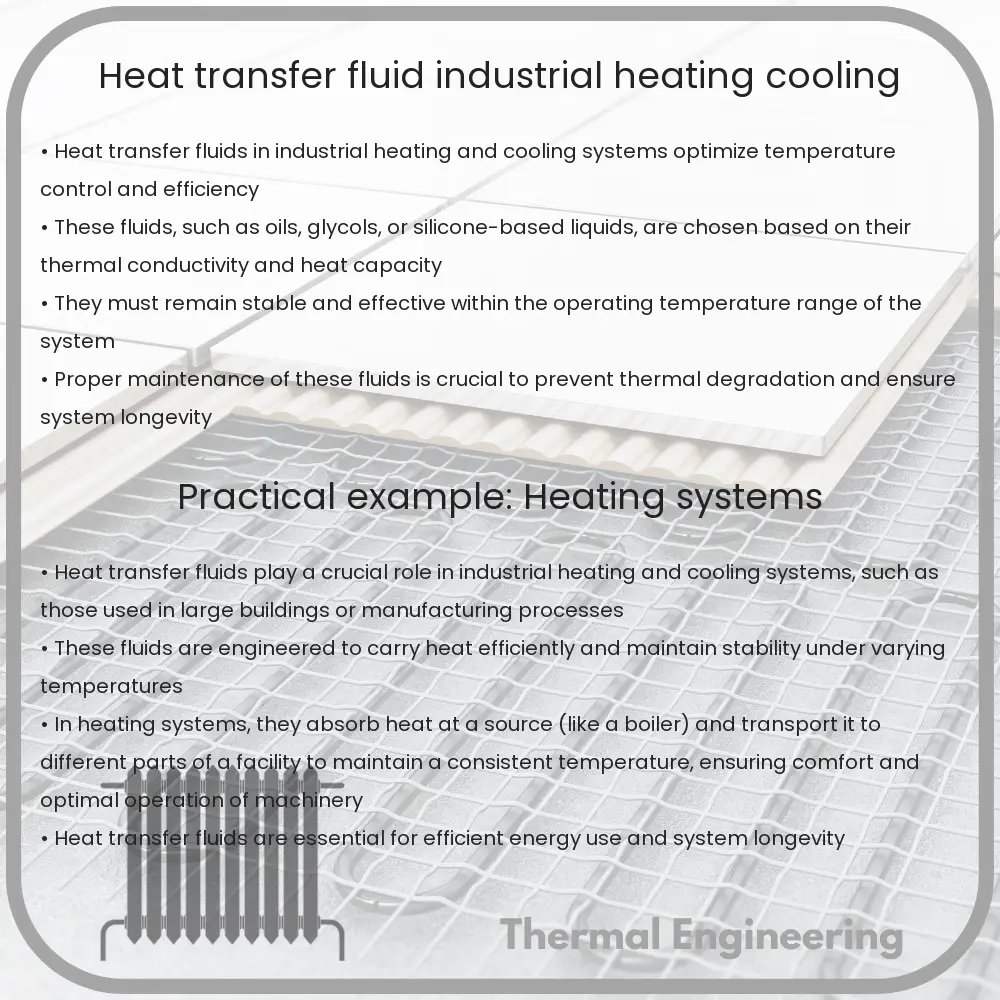Learn about heat transfer fluids (HTFs), their types, mechanisms, and applications in industrial processes.

Understanding Heat Transfer Fluids in Industrial Heating and Cooling
Heat transfer fluids (HTFs) play a crucial role in regulating temperatures in various industrial processes. These fluids are essential for carrying thermal energy from one place to another, effectively helping in both heating and cooling applications. Let’s explore how HTFs function, their types, and their applications in industry.
What is a Heat Transfer Fluid?
A heat transfer fluid is a specialized substance—typically a liquid or gas—that is used to transfer heat from one part of a system to another. These fluids are designed to possess high thermal conductivity and to maintain their physical and thermodynamic properties at different temperatures.
Types of Heat Transfer Fluids
- Synthetic Organic Fluids: Comprised of hydrocarbon-based compounds, these fluids are used in a variety of high-temperature applications. They are known for their stability and low viscosity at high temperatures.
- Silicone Fluids: Known for their excellent thermal stability and wide temperature range capabilities. Silicone fluids are commonly used where low toxicity and non-flammability are needed.
- Glycol-based Fluids: These include ethylene glycol and propylene glycol. Primarily used in applications where freezing might occur, glycol fluids are effective in both heating and cooling systems.
- Mineral Oils: These fluids are generally less expensive and are best suited for moderate temperature applications. Mineral oils are predominantly used in industrial manufacturing processes.
- Water: One of the most commonly used heat transfer fluids due to its high heat capacity and easy availability. It’s typically used in systems where temperatures remain within a range that water can accommodate without phase change (freezing or boiling).
Principles of Heat Transfer in Fluids
Heat transfer in fluids can occur through three primary mechanisms: conduction, convection, and radiation. In HTFs, conduction and convection are more prevalent:
- Conduction: This is the transfer of heat through direct molecular collision. An area of higher temperature passes its energy to an area of lower temperature within the fluid.
- Convection: This mechanism involves the movement of fluid itself. Warmer fluid becomes less dense and rises, whereas cooler fluid descends because it is denser. This cycle, often aided by a pump or other mechanical aid in industrial settings, enhances the heat transfer process.
Radiation, though less significant in fluids, can still occur, especially in high-temperature environments.
Applications of Heat Transfer Fluids in Industry
- Chemical Industry: HTFs are used for regulating the desired temperatures in chemical reactors or distillation columns.
- Plastics Industry: Used extensively to control the temperature during processes such as injection molding and extrusion.
- Food and Beverage Industry: Essential for applications like distillation, drying, and cooking processes.
- Solar Power Plants: High-temperature organic fluids or molten salts are used in solar thermal power plants to store and transfer heat from solar collectors to the steam generators.
- Pharmaceuticals: Maintaining precise temperature control is essential in the manufacture of pharmaceutical products, and HTFs facilitate this requirement.
Choosing the Right Heat Transfer Fluid
Selecting an appropriate HTF is crucial for the efficiency and safety of an industrial process. Factors to consider include:
- Thermal Stability: The fluid should maintain its properties over the operating range of temperatures.
- Viscosity: Lower viscosity at operating temperature leads to better heat transfer and flow characteristics.
- Corrosiveness: The fluid should not corrode the components of the system.
- Cost-effectiveness: Includes both the initial cost and the maintenance or replacement costs associated with the fluid.
In conclusion, heat transfer fluids are indispensable in multiple industrial sectors, improving energy efficiency and process control. By understanding their properties and mechanisms, industries can optimize their heating and cooling processes to achieve better performance and cost-effective operations.